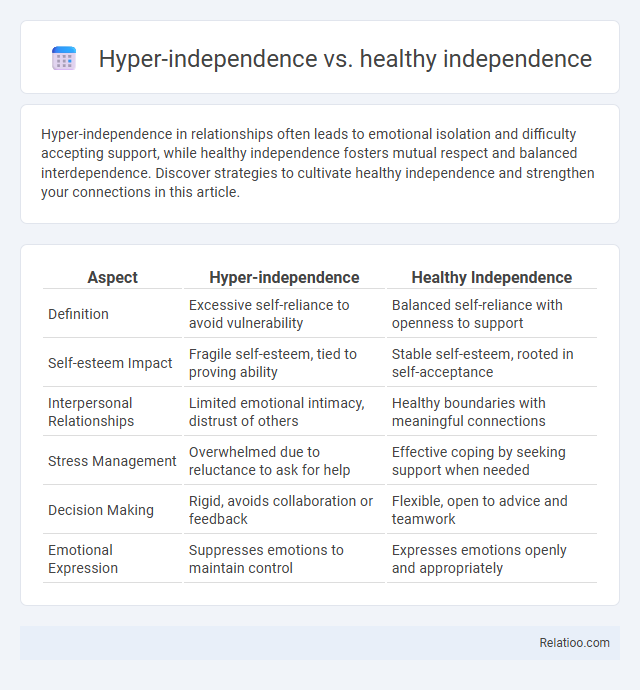Hyper-independence in relationships often leads to emotional isolation and difficulty accepting support, while healthy independence fosters mutual respect and balanced interdependence. Discover strategies to cultivate healthy independence and strengthen your connections in this article.
Table of Comparison
| Aspect | Hyper-independence | Healthy Independence |
|---|---|---|
| Definition | Excessive self-reliance to avoid vulnerability | Balanced self-reliance with openness to support |
| Self-esteem Impact | Fragile self-esteem, tied to proving ability | Stable self-esteem, rooted in self-acceptance |
| Interpersonal Relationships | Limited emotional intimacy, distrust of others | Healthy boundaries with meaningful connections |
| Stress Management | Overwhelmed due to reluctance to ask for help | Effective coping by seeking support when needed |
| Decision Making | Rigid, avoids collaboration or feedback | Flexible, open to advice and teamwork |
| Emotional Expression | Suppresses emotions to maintain control | Expresses emotions openly and appropriately |
Understanding Hyper-Independence and Healthy Independence
Understanding hyper-independence involves recognizing an excessive self-reliance that may hinder accepting help or forming close connections, often stemming from past trauma or fear of vulnerability. Healthy independence, on the other hand, reflects a balanced ability to rely on yourself while maintaining openness to support and interdependence, fostering emotional resilience and personal growth. Your awareness of these differences can improve relationships and promote mental well-being by encouraging healthier coping mechanisms and social interactions.
Defining the Core Differences
Hyper-independence involves excessive self-reliance to the point of avoiding help or connection, often driven by fear of vulnerability, whereas healthy independence balances autonomy with the ability to seek support when needed. Healthy independence fosters resilience and self-sufficiency while maintaining interpersonal relationships, promoting emotional well-being. Hyper-independence can lead to isolation and stress, contrasting with healthy independence, which encourages interdependence and mutual growth.
Roots and Causes of Hyper-Independence
Hyper-independence often stems from deep-rooted experiences such as childhood neglect, trauma, or a need to control one's environment to avoid vulnerability. Your ability to distinguish healthy independence, characterized by self-reliance balanced with interpersonal trust, from hyper-independence influenced by fear of dependence, is crucial for emotional well-being. Understanding these causes helps identify when hyper-independence becomes a protective mechanism rather than a strength.
Psychological Impacts of Hyper-Independence
Hyper-independence often leads to emotional isolation and increased stress due to an unwillingness to seek help or share vulnerabilities, which can exacerbate feelings of loneliness and anxiety. In contrast, healthy independence promotes resilience and self-efficacy by balancing autonomy with interdependence, supporting psychological well-being. The psychological impacts of hyper-independence include impaired relationships, reduced social support, and heightened risk of burnout, emphasizing the importance of fostering healthy independence for optimal mental health.
Traits of Healthy Independence
Healthy independence is characterized by a balanced sense of self-reliance combined with the ability to seek support when necessary, fostering emotional resilience and adaptability. This trait includes effective decision-making skills, self-confidence without arrogance, and maintaining interdependence within relationships to promote mutual trust. Unlike hyper-independence, which often entails isolation and reluctance to accept help, healthy independence supports personal growth while valuing meaningful connections.
Signs You May Be Hyper-Independent
You may be hyper-independent if you consistently avoid asking for help, even when tasks become overwhelming, or if you feel uncomfortable relying on others for emotional support. Signs include a strong desire to control every aspect of your life, difficulty delegating responsibilities, and reluctance to share vulnerabilities. This contrasts with healthy independence, which balances self-reliance with meaningful connections, and hyper-independence, which can lead to isolation and burnout.
How Healthy Independence Fosters Growth
Healthy independence fosters growth by balancing self-reliance with openness to support and collaboration, enabling you to develop resilience and adaptability. Unlike hyper-independence, which often leads to isolation and missed opportunities for learning, healthy independence encourages seeking help when needed and leveraging collective resources. This approach promotes emotional well-being and continuous personal and professional development.
Balancing Self-Reliance and Connection
Balancing hyper-independence, healthy independence, and codependence requires cultivating your ability to rely on yourself while maintaining meaningful connections with others. Healthy independence fosters personal growth and confidence without isolating you or neglecting emotional support. Striking this balance promotes well-being by integrating self-reliance with authentic relationships, avoiding the extremes of isolation or excessive dependency.
Overcoming Hyper-Independence Patterns
Overcoming hyper-independence patterns involves recognizing the difference between healthy independence, which fosters self-reliance and balanced decision-making, and hyper-independence, characterized by excessive self-sufficiency that impedes collaboration and support-seeking. Strategies include cultivating trust in others, embracing vulnerability, and practicing effective communication to build interdependence without losing autonomy. Developing emotional awareness and seeking professional guidance can further aid in transforming hyper-independence into a sustainable, healthy independence that enhances personal and relational growth.
Nurturing Healthy Independence in Daily Life
Nurturing healthy independence involves balancing self-reliance with the ability to seek support when needed, fostering resilience and personal growth. Unlike hyper-independence, which often leads to isolation and difficulty accepting help, healthy independence encourages interdependence and emotional intelligence. Daily practices such as setting achievable goals, cultivating self-awareness, and maintaining supportive relationships promote sustainable independence and well-being.

Infographic: Hyper-independence vs Healthy independence
 relatioo.com
relatioo.com